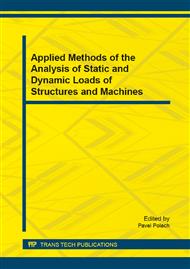p.309
p.313
p.321
p.325
p.329
p.333
p.337
p.341
p.345
Non-Destructive Testing during the Hardening of Alkali-Activated Slag
Abstract:
Non-destructive acoustic analysis methods, Impact-echo method as a traditional and the Acoustic Emission method as nontraditional method for civil engineering, were used for experiment. This paper reports the experiment during hardening and drying of specimens of alkali activated slag mortars. Alkali activated slag is a material having a great potential to be used in practice. The main drawback of this material is a high level of autogenous and especially drying shrinkage, which causes a deterioration of the mechanical properties. The aim of this paper is introduce the effect of method used and time curing on the microstructure of alkali activated slag mortars. An understanding of microstructure–performance relationships is the key to true understanding of material behaviours.
Info:
Periodical:
Pages:
329-332
Citation:
Online since:
February 2015
Authors:
Price:
Сopyright:
© 2015 Trans Tech Publications Ltd. All Rights Reserved
Share:
Citation:


